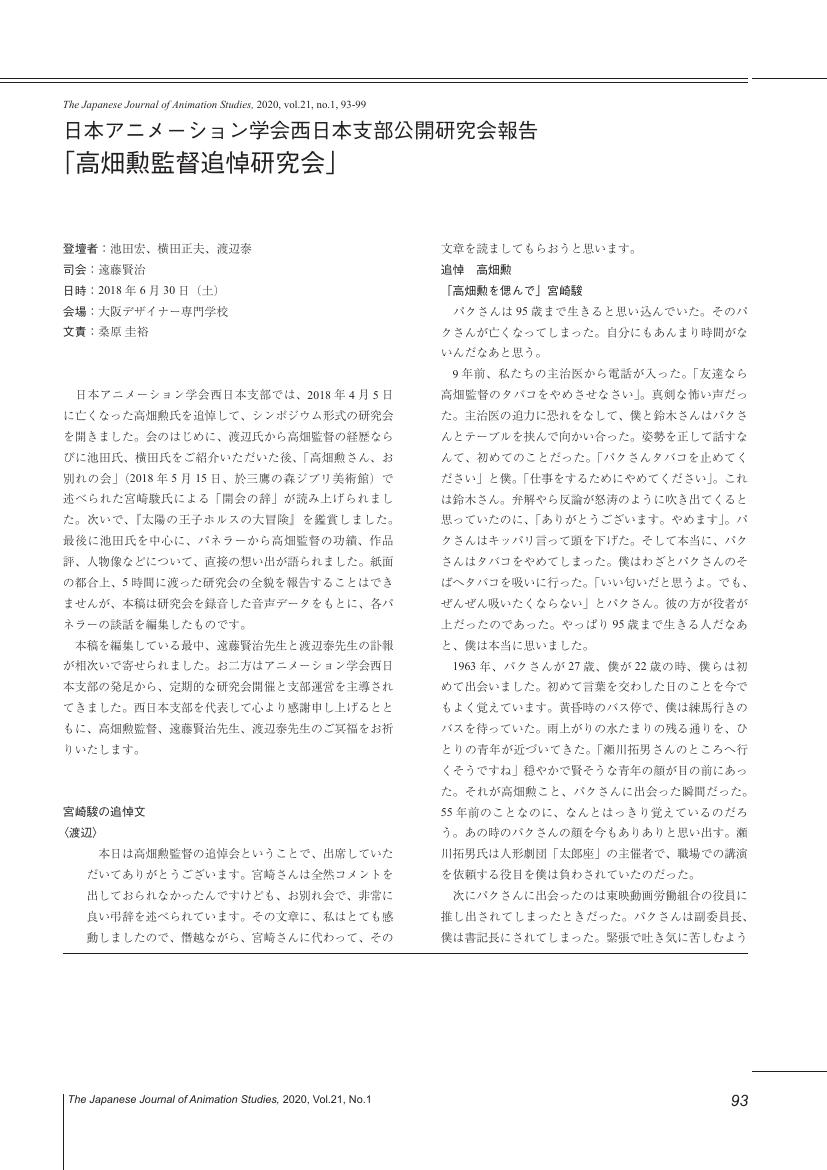132 0 0 0 OA 映像と音の同期―「動画先行の原則」の根拠と応用
- 著者
- 桑原 圭裕
- 出版者
- 日本映像学会
- 雑誌
- 映像学 (ISSN:02860279)
- 巻号頁・発行日
- vol.102, pp.54-74, 2019-07-25 (Released:2019-11-19)
- 参考文献数
- 39
アニメーション制作の現場では、動画と音の同期に関して「動画は音より2フレーム前にすると仕上がりが良い」という「動画先行の原則」が語られてきた。たとえば映像と音楽の一体をテーマに 1929 年から 10 年間にわたって制作されたディズニーの短編アニメーション映画シリーズ「シリー・シンフォニー(The Silly Symphony)」の諸作品をコンピューターで解析すると、確かに時代がくだるにつれて動画を先行させるようになってきた事実を確認することができる。しかし、この動画先行の原則は、あくまで映像制作者たちの経験則に基づいており、その科学的な根拠はこれまで十分には解明されてこなかった。実写かアニメーションかを問わず映像制作の現場において、我々が映像と音を知覚する際に双方のずれを感ずるのは、3 フレーム以上、時間にしておよそ 0.1 秒以上といわれている。したがって、「動画先行の原則」について論じるためには、感覚刺激が脳に到達するまでの問題として知覚心理学の理論を援用する必要がある。本稿の目的は、このようなフレーム処理が一部の実制作の現場で採用されるようになった経緯の背景にある理論的根拠を提示するとともに、このように時間を先取りする手法が、アニメーションに限らず映像全般において、その芸術としてのダイナミズムをもたらしていることを、具体的な作例の分析を通して明らかにすることにある。
11 0 0 0 IR 日本アニメーションにおける動きの研究
2 0 0 0 OA 横田正夫編『アニメーションの心理学』誠信書房、2019年9月
- 著者
- 桑原 圭裕
- 出版者
- 日本映像学会
- 雑誌
- 映像学 (ISSN:02860279)
- 巻号頁・発行日
- vol.104, pp.282-286, 2020-07-25 (Released:2020-08-25)
2 0 0 0 OA 日本アニメーションにおける動きの研究
- 著者
- 桑原 圭裕 Yoshihiro Kuwabara
- 雑誌
- 博士学位論文 : 内容の要旨と審査結果の要旨
- 巻号頁・発行日
- no.51集, pp.31-33, 2012-05-31
1 0 0 0 OA 日本アニメーション学会西日本支部公開研究会報告「高畑勲監督追悼研究会」
- 著者
- 桑原 圭裕
- 出版者
- 日本アニメーション学会
- 雑誌
- アニメーション研究 (ISSN:1347300X)
- 巻号頁・発行日
- vol.21, no.1, pp.93-99, 2020-09-30 (Released:2021-05-07)
- 著者
- 桑原 圭裕
- 出版者
- 日本映像学会
- 雑誌
- 映像学 (ISSN:02860279)
- 巻号頁・発行日
- vol.105, pp.117-120, 2021-01-25 (Released:2021-02-25)
1 0 0 0 映像と音の同期―「動画先行の原則」の根拠と応用
- 著者
- 桑原 圭裕
- 出版者
- 日本映像学会
- 雑誌
- 映像学 (ISSN:02860279)
- 巻号頁・発行日
- vol.102, pp.54-74, 2019
<p>アニメーション制作の現場では、動画と音の同期に関して「動画は音より2フレーム前にすると仕上がりが良い」という「動画先行の原則」が語られてきた。たとえば映像と音楽の一体をテーマに 1929 年から 10 年間にわたって制作されたディズニーの短編アニメーション映画シリーズ「シリー・シンフォニー(<i>The Silly Symphony</i>)」の諸作品をコンピューターで解析すると、確かに時代がくだるにつれて動画を先行させるようになってきた事実を確認することができる。しかし、この動画先行の原則は、あくまで映像制作者たちの経験則に基づいており、その科学的な根拠はこれまで十分には解明されてこなかった。実写かアニメーションかを問わず映像制作の現場において、我々が映像と音を知覚する際に双方のずれを感ずるのは、3 フレーム以上、時間にしておよそ 0.1 秒以上といわれている。したがって、「動画先行の原則」について論じるためには、感覚刺激が脳に到達するまでの問題として知覚心理学の理論を援用する必要がある。</p><p>本稿の目的は、このようなフレーム処理が一部の実制作の現場で採用されるようになった経緯の背景にある理論的根拠を提示するとともに、このように時間を先取りする手法が、アニメーションに限らず映像全般において、その芸術としてのダイナミズムをもたらしていることを、具体的な作例の分析を通して明らかにすることにある。</p>
1 0 0 0 OA 映像と音の同期に関する考察 〇・一秒のリアリティー
- 著者
- 桑原 圭裕
- 出版者
- 美学会
- 雑誌
- 美学 (ISSN:05200962)
- 巻号頁・発行日
- vol.68, no.2, pp.161, 2017 (Released:2019-01-02)
1 0 0 0 OA ロバート・アルトマンのアンサンブル映画 : サブリミナル・リアリティを起点として
- 著者
- 桑原 圭裕
- 出版者
- 美学会
- 雑誌
- 美学 (ISSN:05200962)
- 巻号頁・発行日
- vol.61, no.1, pp.133-144, 2010-06-30 (Released:2017-05-22)
Robert Altman (1925-2006) is one of the famous film directors representing "Hollywood Renaissance", and his work is quite distinct from the classical narrative mode. He asserts that his goal of the film is to capture "Subliminal Reality". In preceding studies about his works, Robert T. Self defines characteristic representations of Altman's film as Subliminal Reality and positions it as an art cinema which is explicitly against Classical Hollywood Cinema. He is also well known by the ensemble film which focuses on multiple characters. Altman tried to make this mode of films concerning a view of subliminal reality. I have to deeply look into the film, Short Cuts (1993) in Altman's ensemble films, because it added a new aspect to previous films. The story of Short Cuts tracks the daily lives and interactions of a large cast of seemingly unrelated characters. Recently, other directors have also used the method of story telling like Short Cuts, which has the tendency to attract audience's attention and it has become a new form of narrative structure. But this movement means a certain contradiction. Even though Altman's ensemble film is based on subliminal reality which is antithetical to a mode of Classical Hollywood Cinema, why is it also received as Modern Hollywood movement? In this process, we can find a feature of Altman's subliminal reality as art cinema mixed with classical narrative mode.
- 著者
- 桑原 圭裕
- 出版者
- 美学会
- 雑誌
- 美学 (ISSN:05200962)
- 巻号頁・発行日
- vol.60, no.1, pp.198-199, 2009-06-30 (Released:2017-05-22)
1 0 0 0 OA 映画的なるものとしてのフォトジェニー : ポール・トーマス・アンダーソン作品を中心に
- 著者
- 桑原 圭裕 Yoshihiro Kuwabara
- 雑誌
- 人文論究 (ISSN:02866773)
- 巻号頁・発行日
- vol.64, no.3, pp.37-57, 2014-12-20
1 0 0 0 OA 日本アニメーションにおける動きの研究
- 著者
- 桑原 圭裕 Yoshihiro Kuwabara
- 巻号頁・発行日
- 2011




